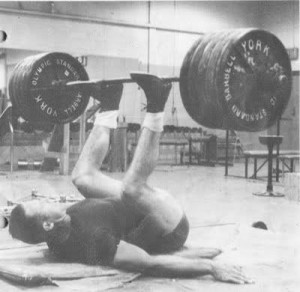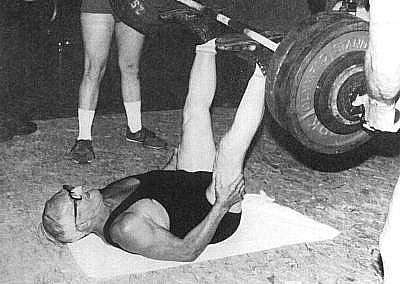No Stupid Lifts, Just Stupid Lifters
by Thom Van Vleck
Recently I got kind of sore at a guy for criticizing a leg press done by my friend Wilbur Miller. Wilbur and my Uncle Wayne had some epic battles back in the day and while Wilbur won the overall in every meet he was never able to beat my Uncle in the Clean and Press. Wayne took great pride in that as Wilbur was, in his mind, the greatest of his era. I have written an article for MILO magazine on Wilbur and he continues to be involved in the USAWA to this day.
So this picture came up and this guy took it for face value and called it “Stupid”. Well, I let him have it. I was probably too harsh but I knew the story behind this photo. The guy also said that if this was a good lift then you would see people doing it everywhere. First of all, Wilbur usually did his lifting in an old York Power Rack where he could leg press in a rack with a very tight gap. I did leg pressed that way early in my training as well. Second of all, this photo was take out of the rack to demonstrate the lift. Third, Wilbur did them because he didn’t have a proper leg press or leg sled. It might be stupid to do this lift if you had a good leg press or out of a power rack….but it was dang smart to do them when Wilbur had some back issues and wanted to work his legs hard and he had no other recourse.
This got me to thinking about all the name calling and commentary from know-it-all lifters on the internet. And to be honest, I’ve been one, too and I regret it. A quick glance and you might think a lot of lifts would be useless or even dangerous. But the reality is there are no stupid lift…only stupid lifters!
I would contend that ANY lift that can be done could have a useful purpose at some point of any lifters career. Maybe because of injury, or an unusual weakness, or a lack of proper equipment. Over the years I have made it a point to train with many of the best lifters in the country and I have found that almost ALL of the best have all kinds of unusual lifts they have developed that fits their needs. Those same lifts, in the wrong context, could be disastrous to others.
Many times I have had a lifter tell me of a lift they do and my initial reaction is to roll my eyes and shake my head. But in my 35 plus years of lifting there have been countless times I’ve ended up adopting that lift for my own needs. So, my point is don’t judge, keep your mind open, and be like a U. S. Marine: “Improvise, Adapt, and Overcome”. In other words….don’t be stupid!

